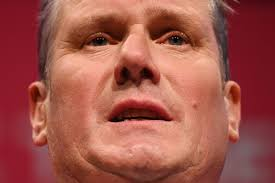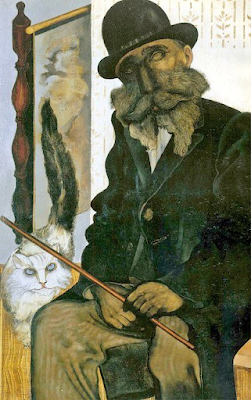Polish-Jewish avant garde painter, printmaker and revolutionary, graphic artist Jankel Adler was born into a large orthodox Jewish family on 26 July 1895 in Tuszyn, near Łódź, Congress Kingdom of Poland, then client state of the Russian Empire (now Poland). and was the seventh in a family of ten children.
He studied engraving in Belgrade in 1912, then art in Barmen and Düsseldorf until 1914. During the First World War he was conscripted into the Russian army but returned to Poland in 1918, becoming a founder-member of Young Yiddish, a Łódź-based group of painters and writers dedicated to the expression of their Jewish identity, the first of the many avant-garde artistic groups with which he would be associated. In 1920 he moved to Germany, meeting Marc Chagall in Berlin, then returned briefly to Barmen, before settling two years later in Düsseldorf, where he joined the Young Rhineland circle, became friendly with Otto Dix and helped found the International Exhibition of revolutionary artists in Berlin.
In the 1920s he joined the activities of left-wing avant-garde groups in Düsseldorf, Cologne, and Berlin. His intense engagement with wall painting during this period influenced his painting technique, which involved scratching patterns into a mixture of oil paint and sand.
In 1925 Adler's Planetarium frescos were well received and he exhibited widely. Six years later, in 1931, as a Professor at the Düsseldorf Academy, he formed an important friendship with Paul Klee, who had a profound influence on his style.
Jankel Adler The Artist (1927).
During the 1920s and the early 1930s, his individual artistic manner crystallized, organically combining elements of cubism, primitivism, expressionism, and
"Neue Sachlichkeit." At the same time, he often incorporated images of Jews, Jewish inscriptions, and kabbalistic symbols into his compositions by making use of the cards of the mezuzah and fragments of prayers.
Sabbath was made in 1927/28 during the artist's brief period of success in Düsseldorf. At that time he was at the center of a small Jewish art community that probably included Düsseldorf lawyer Joseph Gottlieb.
Jankel Adler Sabbath, 1927-28
Jankel Adler - The cat breeder, 1925J
Adler’s political stance could be described as a kind of anarchist communism, from which nothing was further than submission to a Leninist party discipline that was already dominating the KPD the major far-left political party in the Weimar Republic at that time. And before the Reichstag elections in March 1933, he joined fellow leftist artists and intellectuals, in signing an Urgent Appeal against the rise of fascism and for communism.
His life turned dramatically with Hitler’s rise to power. As a modern artist, a member of radical groups and especially as a Jew, he faced persecution under Hitler's regime which took power in 1933. In that year, two of his pictures were displayed by the Nazis at the Mannheimer Arts Center as examples of degenerate art, and Adler left Germany, staying in Paris where he regarded his exile consciously as political resistance against the fascist regime in Germany.
In the years that followed, he made numerous journeys to Poland, Italy, Yugoslavia, Czechoslovakia, Romania and the Soviet Union. He also spent time in Paris, working at Atelier 17. In 1934 his work was included in the Exhibition of German-Jewish Artists' Work Painting - Sculpture - Architecture , mounted by German refugee art dealer, Carl Braunschweig at the Parsons Gallery, Oxford Street (5-15 June 1934), organised in response to such Nazi discrimination.
The Nazis seized 25 of his works from public collections two of his works were displayed at the Mannheimer Arts Center as examples of degenerate art in 1933. nd a number were displayed in the infamous Entartete Kunst (Degenerate Art) exhibition, mounted by the Nazis in Munich in 1937.
In the same year, he worked with the printmaker Stanley William Hayter at the experimental workshop Atelier 17 in Paris, also meeting Picasso, who became the second major influence upon his style.
In 1939,at the age of 45, his long abhorrence of Nazi aggression saw him join the Polish free Army which was assembled in France in early 1940, and with them fled the advancing German troops via the Brittany port of St. Nazaire. He arrived in Scotland, penniless and in poor health, and after a brief time in a camp, was discharged soon afterwards.
He found temporary accommodation with a minister in Coatbridge in North Lanarkshire, about 10 miles east of Glasgow, moving shortly afterwards to the famous port city on the River Clyde, known for its rich industrial and shipbuilding heritage, where he remained until the summer of 1942.
Once again, he faced the uncertain task of attempting to rebuild his life, career and reputation in a foreign land, this time in a country where he was completely unknown. Adler, thoughby now an experienced refugee, was nothing if not resilient, and upon arrival set to work with such 'a furious determination',that in the short time remaining to him, he not only completed a large body of new work, but also established himself as a painter of reputation and influence in his third and final host country. and in Glasgow, he became one of a number of other influential refugees escaping Fascist oppression. who enhanced the artistic life of the city.
He exhibited his work at the New Art Club, established by J D Fergusson and was associated with the Scott Street Art Centre established by David Archer as a meeting place and resource centre.
rejection of figurative manner and transition to symbolic abstraction.
A number of his works created in this period treated "
Jewish themes" and reflect his understanding of the Holocaust (as in Two Rabbis, 1942; Museum of Modern Art, New York).
Adler's resilience and creativity found new life in Britain, where he became a key figure in the émigré artistic community. In Glasgow he was befriended by Estonian-Jewish émigré sculptor Benno Schotz, through whom he renewed his friendship with Josef Herman, a fellow Polish artist who had moved to Glasgow in 1940. ‘It was with Jankel that I could share my more intimate fears’, Herman recalled later with gratitude. ‘These were years of fears. Both of us were Yiddish-speaking, we were both from Poland, hence we could look into each other’s faces with understanding. In the company of others we were a conspiracy of two.’
Kindred spirits, they supported each other emotionally, Herman’s presence in Glasgow undoubtedly helped Adler recover his strength and resume activity as an artist.and they became two of the most influential members of the Glasgow New Art club, founded by J. D. Fergusson
Adler arrived at a powerful and eloquent final phase in his career. The undertow of tragedy running through these images must have intensified in 1942 when Herman was told, by the Red Cross, that his entire family had been exterminated by the Nazis in the Warsaw Ghetto.
Herman suffered a total breakdown and, according to his future wife Nini, ‘Jankel Adler stepped in and nursed Josef through those weeks with maternal tenderness. Was it perhaps to heal them both.’
Jankel Adler's 'Orphans' 1941 is a poignant painting which shows Adler and his friend Josef Herman.
Adler gifted the work to Herman, who kept it all his life.
The Estonian-born Jewish sculptor Benno Schotz organised a private exhibition of Adler's work in his own studio in 1941 and Adler also exhibited 24 works at Annans' Gallery in June the same year.
The Mutilated was painted in London in 1942 during heavy bombing and reflected, he said, his admiration for "the behaviour of Londoners under great stress and suffering, only then could humanity be seen at its best".
In October 1942 Adler contributed a short article 'Memories of Paul Klee' to Cyril Connolly's Horizon and in December of the same year, Schotz and Herman organised an exhibition of Jewish Art at the Jewish Institute, South Portland Street, in the Gorbals, Glasgow. This included work by Adler, alongside both British Jewish artists including David Bomberg and continental European Jewish artists, many associated with the Ecole de Paris, including Chagall, Modigliani and Soutine, as well as by the curators themselves.
In 1942 Adler also stayed briefly in the artists' colony in Kirkcudbright in South West Scotland, in order to prepare for his upcoming solo exhibition at the Redfern Gallery in Cork Street, London (June-July 1943), organised by German émigrée art dealer Erica Brausen and with a catalogue introduction by the influential art historian and critic Herbert Read.
After moving to London, in 1943 he applied for British citizenship, hoping to bring his daughter and mother to live with him, but his application was rejected. Adler shared a house with 'the two Roberts', the painters Colquhoun and MacBryde, whose style he greatly influenced, and their wider circle.
Jankel Adler still life 1943
Painted in 1943 during the Second World War, Beginning of the Revolt is an essentially tragic and anarchic view of the human condition that closely relates to No Man's Land of the same year in the collection of the Tate Gallery, London.
Jankel Adler No Man's Land
Underpinning Adler’s painting
Beginning of the Revolt is an intensely organized structure and carefully composed response to the turmoil of his time. Here, a raven, symbol of death and sadness, has come to roost among the amputated, mutilated branches of a rootless, dead tree.
Where there was previously life there is now desolation. The muted palette heightens the ghostly bleakness of the scene, conveying a sense of silent despair.
The title of the painting, however, suggest resilience and revolt– despair and desolation will not lead to defeat. Death will lead to rebirth and new beginnings.
Jankel Adler Beginning of the Revolt
In 1944 he participated in a group show in German émigré Jack Bilbo's Modern Art Gallery and also had two solo exhibitions at Gimpel Fils, Studies in Tempera for Kafka's Works by Jankel Adler with Watercolours and Drawings, in spring 1947, followed by a second show in 1948. In the same year, An Artist Seen from One of Many Possible Angles, with illustrations by Adler, was the first publication from Polish-born Francziska and Stefan Themerson's avant-garde Gabberbochus Press.
It was only after the war, in 1945, that he learned bitterly that all eleven of his siblings had been killed by the fascists. In 1945 the collector James (Jimmy) Bomford lent Adler Whitley Cottage, situated on his farm at Aldbourne, near Malborough, in Wiltshire, where the artist spent his final years.
It was there on 25 April 1949 - a day after hearing of the rejection of his application for naturalisation, probably because had described himself as an ‘anarchist’ and depressed and frustrated by the process that at he suffered a heart attack and died in poverty aged only 53.
The Marlborough Times reported that ‘he had endeared himself to quite a few who came to know him,and were impressed by his genial disposition and gentle character’. He was buried in the Jewish cemetery in Bushey, Herts, but his memory lives on. and like all great artists his vision is unique and instantly recognisable.While his achievements during his life deserve full recognition.
Extensive materials relating to his time in Britain are held in the archives of the National Galleries of Scotland, as well as the Tate Archive. His work is held in UK collections including Aberdeen Art Gallery, Glasgow Museums Resource Centre, Pallant House Gallery, Swindon Museum and Art Gallery and Tate Britain, as well as in international collections in Australia, Germany, Israel and the USA.
Two Figures, 1944, by Jankel Adler

.jpg)



.jpg)











